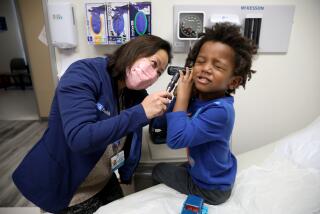Free Clinics Expand as ‘Business’ Booms
- Share via
SCHENECTADY, N.Y. — After Rick Sawyer had a heart attack last year, he found himself staring down a huge stack of hospital bills.
For the first time in his life, Sawyer, 60, of Scotia, N.Y., had no health insurance. He soon became one of the growing cross-section of racial and economic demographics turning to free clinics for medical care.
The National Assn. of Free Clinics estimates there are about 2,000 such clinics today generating about $3 billion in healthcare services annually.
With about 46 million uninsured people in the nation today, those clinics are rapidly growing to accommodate a flood of patients.
The Schenectady Free Clinic, where Sawyer went for help, started in two rooms in a run-down former school building just a year ago. Driven by demand, the clinic is now in a spacious new office lined with a small pharmacy and six exam rooms.
“Quite frankly, we’re keeping patients out of the emergency room,” said William Spolyar, the clinic’s director. “Providers donate services and equipment, but we’re saving them oodles of money.”
It’s no surprise that free clinics, which are run by volunteers and survive on grants and donations, are seeing growing support in their communities.
According to the Institute of Medicine, an advisory arm of the National Academies, a group of science and technology experts, the uninsured population costs the country between $65 billion and $130 billion every year.
“As the national statistics on the uninsured has crossed all professional and racial lines over the years, we’ve seen a representation of that change,” said Linda Feldman, spokeswoman for the Venice Family Clinic in Los Angeles, one of the largest free clinics in the nation.
At Venice, it’s not unusual to get patients who are recent college graduates or who come from suburban backgrounds.
“When people say free clinic, you think of tiny buildings that administer to homeless people and drug addicts,” said Eric Moore, who went to the clinic a few years after graduating from UCLA. “You don’t think it’s for people who are working.”
Now a substitute teacher, Moore, 35, had been working two part-time jobs with no health insurance when a blood clot formed in his left leg.
The bulk of free-clinic patients earn too much to qualify for government assistance, yet too little to afford health insurance -- Moore’s former situation.
According to the Robert Wood Johnson Foundation, a philanthropy group that advocates healthcare access, 80% of the nation’s uninsured either work or are in working families.
Among the uninsured working population, 56% work full-time year-round, while the remainder work part-time -- sometimes juggling two or three jobs.
Still, free clinics nationwide annually serve about 3.5 million people, a fraction of the nation’s uninsured.
“They’re Band-Aid solutions until we have a more nationalized way of addressing the issue,” said Elizabeth B. Forer, director of the Venice Family Clinic.
The services provided at a clinic can vary depending on its circumstances, its staff and the community it serves.
The Mission East Dallas in Texas provides root canals and tooth extractions because many of its 130 volunteers are dentists. The clinic, which uses the pews of a former church as a waiting room and the ladies’ room as a triage area, plans to break ground on a new facility in spring 2007.
The Moore Free Care Clinic in central North Carolina, meanwhile, runs a popular physical therapy class for their many patients with back pain. A volunteer there works as a physician’s assistant with back specialists.
Although it’s just over a year old and still operates out of a donated office in the county health department building, the Moore clinic also is expanding its hours to accommodate the growing lines of patients turning up at its doors.
The Venice Family Clinic is an example of how sophisticated a makeshift free clinic can become out of sheer demand for services.
When it first started in 1970, it saw patients in the chairs of a donated dental office after business hours. It rapidly evolved and now sees 22,000 patients a year at seven sites in Southern California.
The Schenectady Free Health Clinic served 1,232 patients in 2005, up from 303 in 2004. Although it just moved into its new offices a year ago, it has already had to knock down walls to add more exam rooms.
Demand is so high that the clinic is working with the state Health Department to open 10 more locations throughout the state.
There is already strong interest from volunteer physicians in Oneonta and Ithaca.
“And if that goes well, we’ll ask for 20 more,” Spolyar said.
On the Net:
Cover the Uninsured: www.covertheuninsured.com
More to Read
Sign up for Essential California
The most important California stories and recommendations in your inbox every morning.
You may occasionally receive promotional content from the Los Angeles Times.













